
Gardening for pollinators: Smart plants to support pollinators
DOWNLOADApril 5, 2016 - Rebecca Finneran
 Pollinators are looking for nectar and pollen when foraging in your garden. This is their food, the carbohydrates and protein they need to thrive and produce offspring. Native bees will widely feed on many different types of flowering plants in your landscape and garden.
Pollinators are looking for nectar and pollen when foraging in your garden. This is their food, the carbohydrates and protein they need to thrive and produce offspring. Native bees will widely feed on many different types of flowering plants in your landscape and garden.
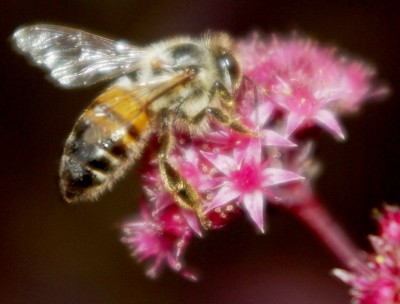
Think about “serving” up a menu of blooms in early spring through fall. Choose a wide range of flowering plants including annuals, herbaceous perennials and native plants, bulbs, trees and shrubs that are known to support pollinator health. Early blooming plants such as spring bulbs or Pachysandra, or very late bloomers such as Sedum or Anemone are often the most needed food sources for pollinators since there are fewer floral resources available during those times.
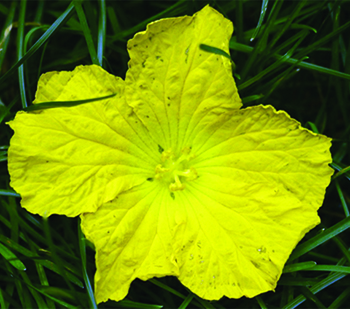
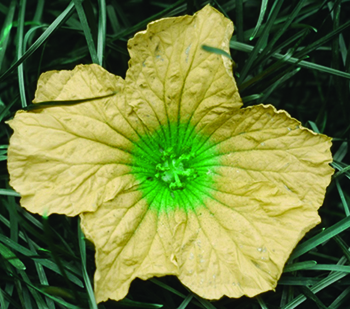
Human vision of a flower (left) versus insect vision (right). Photos by Zachary Huang, MSU.
Some annuals like Tithonia and perennials like Helenium (Sneezeweed) can be encouraged to re-bloom during summer with pruning and routine dead-heading. Other garden favorites have been bred to continue blooming throughout the season. Providing a wide range of bloom sizes and shapes will encourage these insects regardless of the insect’s size. Tubular-shaped flowers with an extended petal, like foxglove or Salvia, allow bees to perch and then enter the bloom. Open flowers with flat umbels like our native ironweed provide resources to many kinds of beneficial insects.
Bees will forage on hundreds of different flowering plants, but they especially love purple, blue, white, yellow, mauve or violet flowers. Using UV light, bees see things in flowers our eyes cannot, including patterns, colors and markings, which enables them to pilot directly to a “landing pad” leading to the pollen source.
Flowers bred to have dense petals such as roses or peonies may not accommodate pollinators since the nectar glands and pollen laden stamens are more difficult to locate. A plant that was bred to be sterile (lacking stamens) or does not contain nectar does not benefit pollinators.
Early show
Early spring-blooming plants such as Pachysandra and bugleweed buzz to life with insect activity when windy spring weather makes it difficult to navigate plants that are taller. Minor bulbs like Siberian squill, Punchkinia and Chinodoxa attract the tiniest of bee species. Perennial favorites such as bleeding heart, foxglove and Allium ‘Purple Sensation’ bring in the late-spring show audience and larger bees are often seen feeding on these beauties.
Prime time
By the time spring unfolds, garden favorites like single peonies reveal their pollen-laden anthers and start receiving attention from bees. New hybrids of coral bells re-bloom throughout the season and well into fall with fresh bloom spikes emerging every couple of weeks. Summer bulbs like Allium christophii and Allium ‘Millenium’ add to the palette and are bee magnets! With Allium cultivars that bloom throughout spring and summer, possibilities are endless.
Mid-season, traditional perennial border plants including sneezeweed, globe thistle and blazing star offer unlimited opportunities for many pollinators to forage. Native and non-native coneflowers are a favorite of bees. Sneezeweed is especially responsive to dead-heading and will continue producing new blooms until frost. Colorful annuals and herbs can really pack a punch with attractive colors while providing a long bloom season. Herbs such as borage are irresistible for many species of bees and hover flies. By choosing sunflowers that are branched and range in days-to-harvest by a week or so, you can provide fresh blooms for a longer period. A tall, late summer annual known as Tithonia starts blooming early August and continues until frost. Butterflies, bees and hover flies covet these flaming-orange blooms. The tall purple orbs of Verbena bonariensis and fragrant annual Heliotrope are heavily used by bees of different sizes. Several zinnia cultivars are rarely visited by bees, however some of the more open types and Zinnia ‘Benary Giant’ are top contenders in annual gardens. Other annuals such as tall salvia (Victoria blue or white), lantana and Pentas add color and provide nectar and pollen for many bee species.
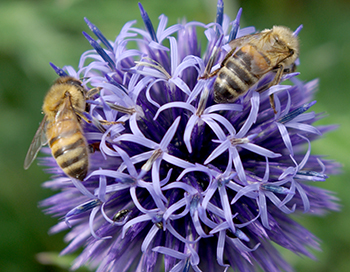
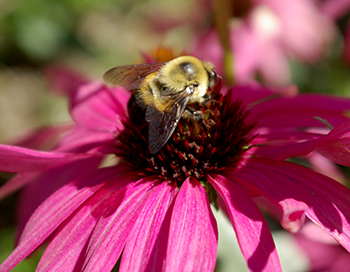
Honey bees on globe thistle (left) and native bee on coneflower (right). Photos by Rebecca Finneran, MSU Extension.
Late show
Sedum has to be one of the most diverse plant groups in gardens. From low-growing, colorful ground covers to the upright stately ‘Autumn Joy’ sedum, their blossoms are intoxicating for many bees and flies. These late-season bloomers help extend available pollen and nectar along with garden favorites including Japanese anemone, sweet smelling snakeroot and Rudbeckia ‘Autumn Sun.’
Native and non-native trees and flowering shrubs play a huge role in supporting pollinators. In early summer, lindens burst into bloom with sweetly scented panicles of yellow blooms tucked beneath their foliage. Button bush, a favorite for moist soil or a wetland edge, blooms in mid-summer, and panicle hydrangeas, with their stately towers of blooms, are visited later by bees and flies. Many types of bees visit the blooms and are supported by these plants.
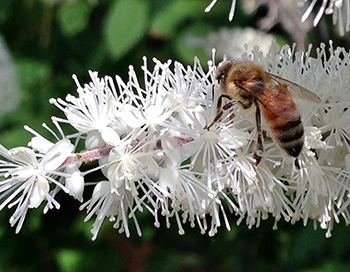
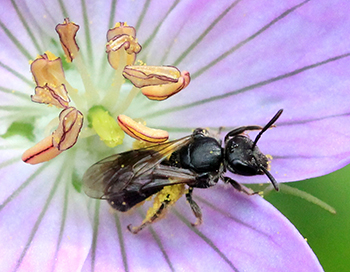
Honey bee on snakeroot (left) and a native bee on geranium (right). Photos by Rebecca Finneran, MSU Extension (left) and Jason Gibbs, MSU (right).
Putting it all together – bee intentional!
Smart gardeners are aware of their gardening actions and activities. While dead-heading plants like sneezeweed encourages additional blooms, early dead-heading of Hosta blooms may rob the pollinators of a great lunch. Blooming coleus may be thought of as unsightly, but not to a bee. A member of the mint family, these small blooms are very attractive to bees. Perhaps it is about the way we think of “tidiness” in the garden and we let some things go.
A field guide, “Bees of the Great Lakes region and wildflowers to support them,” is for sale at the Michigan State University Extension Bookstore if you want to learn more.
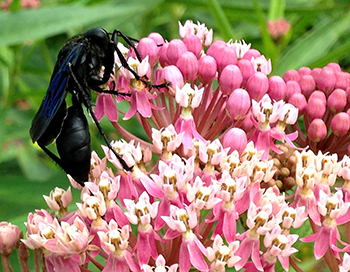
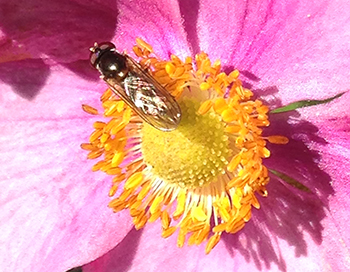
Beneficial insects other than bees are also supported by flowers, such as this predatory wasp on swamp milkweed (left) and hover fly on anemone (right). Photos by Rebecca Finneran, MSU Extension.
The importance of pollinators
Pollinators are essential to our environment and are uniquely linked to our food supply. They pollinate more than 85 percent of the world’s flowering plants and are ultimately responsible for the seeds and fruits that humans, song birds and even black bears consume. Recent concerns about the decline of pollinating insects have caused gardeners to learn how to make positive contributions towards their conservation. Understanding habitat needs and food sources while adjusting our garden maintenance routine is a step forward in pollinator conservation.
One often thinks first of the honey bee as a pollinator, but over 400 species of native bees live in Michigan. Native bees come in many shapes and sizes, and are often uniquely linked with native trees, shrubs and herbaceous plants, but will also work a widely diverse garden plant palette.
Beneficial insects also make up the world’s hardest-working workforce by keeping detrimental insects in check. A diverse selection of native and non-native plants, judicious reduction of pesticide use and observant gardeners come together to create a strategy for preserving bees and other “good bugs” in our landscapes and gardens.



 Print
Print Email
Email





